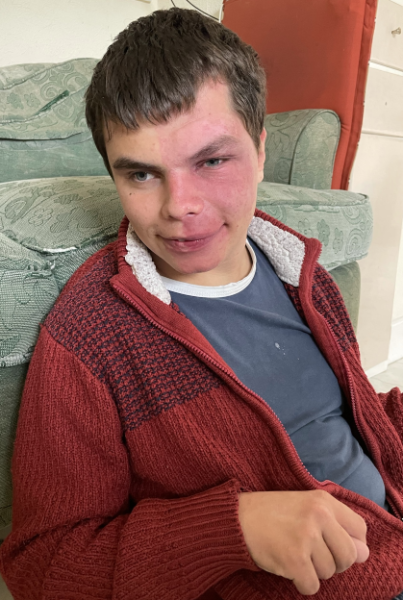What is Sturge Weber Syndrome?
We are learning all about unique, different, and rare epilepsies on The Channel, and that includes Sturge Weber syndrome (SWS). SWS is a rare condition that can affect the skin, brain and eyes. Most children who have it, are born with a birthmark on their face, known as a port-wine stain. This birthmark can occur on one or both sides of the face and may be seen on other parts of the body. Interestingly, people with SWS also have an extra layer of blood vessels over the surface of the brain.
Children diagnosed with SWS may have one or more of the following symptoms, which will usually appear in the first year of life:
- Port-wine stain (pink, red or purple birthmarks)
- Epilepsy
- Glaucoma (high fluid pressure in the eye)
- Headache
- Paralysis or muscle weakness on one side of the body
- Learning disabilities
- Low thyroid (hypothyroidism)
- Features of autism (difficulty expressing themselves and interacting with others)
It’s important to remember that not all children will have every single symptom listed. Also, some SWS symptoms may not develop until a child becomes an adult. SWS occurs in around 1 per 50,000 people. It affects all ethnic groups, in both boys and girls. Sturge Weber syndrome is rare and so it’s very common for people to not have heard of it before. It’s completely normal to have lots of questions when a family member, especially a child, is facing a new diagnosis.

How does Sturge Weber syndrome differ from other types of epilepsy?
Seizures are a common symptom of SWS, and often begin in the year after birth. They can include different types of seizures, such as:
- Focal seizures – also called partial seizures (jerking of one side of the face or limbs, or both)
- Generalised seizures that involve both sides of the body
- Atonic seizures (“drop attacks”) and/or myoclonic (“jerk seizures”) or infantile spasms.
As children with SWS get older, their seizures may happen more often, and become more severe.
A few children diagnosed with SWS may also experience a type of seizure called: status epilepticus. This will require emergency treatment. Status epilepticus is when a seizure lasts longer than 5 minutes, or a person has more than one seizure within a 5-minute period, without returning to their normal level of awareness.
What causes Sturge Weber syndrome?
Sturge Weber Syndrome is caused by a genetic change – that commonly occurs in a gene called GNAQ. This change happens sporadically, early in pregnancy, for no known reason. However, SWS is NOT hereditary, so it is NOT passed from parent to child.
How can it be diagnosed?
The diagnosis of SWS will involve various tests. These include a physical examination to identify port-wine birthmarks. Doctors will also examine the eyes to find any signs of glaucoma. They will also look at a detailed medical history of a child with SWS. If the child is having seizures, the tests may involve:
- Magnetic resonance imaging (MRI): This scan looks at the structure of the brain and may help to find the cause of a person’s epilepsy
- Electroencephalogram (EEG): Can detect changes in brain activity and can be used to diagnose epilepsy and other seizure disorders
Other tests can be done to see if a child has autism, which is found in many people who are diagnosed with SWS.
What are the effects of Sturge Weber syndrome?
Sturge Weber syndrome is a lifelong condition that will need ongoing care and support. Children with SWS can have a range of disabilities and associated problems. So, some children with SWS can have abilities within the normal range and others may have more delayed development.
Does it affect life expectancy?
The average life expectancy of a person with SWS can be different in each person and it depends on the severity of their symptoms. The good news is that most affected children can have a normal life expectancy.
Are there treatments available and is there a cure?
Although there is no cure for SWS, many treatments are available.
Epilepsy treatments:
- Anti-seizure medications: A child with SWS may need a combination of anti-seizure medicines, to control their seizures. The combination and dosage of these medicines may need to be changed as a child becomes a teenager and adult.
- Brain surgery: In a few children with SWS, seizures may not be responsive to any anti-seizure medicines. In these cases, surgery– a hemispherectomy – might be needed. This procedure disconnects or removes the part of the brain that’s causing the seizures.
Port-wine stain (skin) treatments:
- Laser treatment: Can be used to remove or lighten the port-wine birthmark
- Laser treatment can also prevent and remove the skin on port-wine stains from developing grape-like growths of small blood vessels called vascular blebs. Usually, these blebs aren't cause for concern, but they often bleed
Glaucoma treatments:
- Latanoprost: A medicine that treats high pressure inside the eye, in children who have glaucoma.
- Trabeculectomy: A surgical operation that can lower the pressure inside the eye, to help prevent eye pain or vision changes
If you have Sturge Weber syndrome or if you’re caring for someone with this condition, your medical team and other professionals will help you to find the best treatment, social, management and educational plan to achieve a good quality of life. Although Sturge Weber syndrome is a rare condition, you are not alone. Find other parents to chat to on The Hub or reach out to us here if you need someone to talk to.
